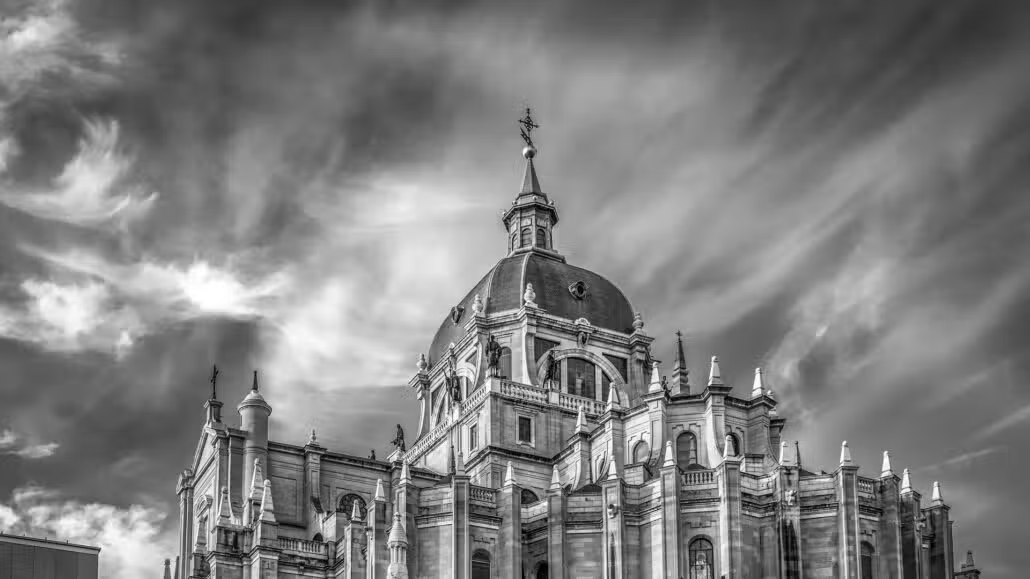Several years ago, 40 pilgrims, with me serving as chaplain, crossed northern Spain by motor-bus. We had the good fortune to visit—in the following sequence—the shrines and birthplaces of four prominent Spanish saints: Saint Teresa of Avila, Saint John of the Cross, Saint Ignatius Loyola, and Saint Francis Xavier.
I’m pleased to share these memories so that readers can follow our path across Spain and become better acquainted with these inspiring saints.
Teresa of Avila: Great Mystic and Carmelite Reformer
Aware that her health was failing, Teresa decided to stop here on her way back to Avila, the city of her birth (in 1515). Today, thousands of pilgrims from all over the world converge on this holy site to venerate her remains in an ornate coffin high above the altar of the convent chapel.
Also of special interest to many visitors, in an exposition room of the adjoining convent, is the incorrupt heart of Saint Teresa. It can be viewed in a glass receptacle set delicately amidst angelic figures.
It is most appropriate that Saint Teresa’s heart is one of the central symbols of this world-famous shrine. Indeed, visitors will see Teresa’s heart being pierced by a spear in various art forms, found both in this shrine and in Avila. Teresa was a great mystic who experienced many visions, raptures and other favors flowing from God’s infinite love.
This most celebrated ecstatic experience of her life is described in her own words in Chapter XXIX of her classic work, The Autobiography of St. Teresa of Avila:
“It pleased the Lord that I should sometimes…see beside me…an angel…in bodily form….He was not tall, but short, and very beautiful, his face so aflame that he appeared to be one of the highest types of angels who seemed all afire….In his hands I saw a long golden spear and at the end of the iron tip I seemed to see a point of fire. With this he seemed to pierce my heart several times,…[leaving] me completely afire with a great love for God.”
Teresa’s life was not easy. Shortly after entering the Convent of the Incarnation in Avila, she had to deal with serious illness. Neither did success in prayer come easy. With persistence and humble trust in God, however, Teresa’s prayer, in time, reached a rich level of maturity and an amazing love-union with God.
She also heard God’s call to reform the Carmelite way of life. She quickly discovered that being a reformer is no way to win a popularity contest. She met immense opposition. But with great trust in God and the collaboration of Saint John of the Cross, Teresa spearheaded the founding of 17 discalced (or reformed) convents for women and two discalced monasteries for men within the Carmelite Order.
Besides her Autobiography, Teresa also wrote several other spiritual classics such as The Way of Perfection and The Interior Castle. It would take a few centuries before her contributions to mystical theology and Christian spirituality were duly recognized. This finally came about when Pope Paul VI declared her a Doctor of the Church in 1970, the first woman to be so honored.
John of the Cross: Finding God in the Darkness
In 1570, he became confessor at Teresa’s Convent of the Incarnation at Avila. But storms of controversy between the reformers and those fighting the reform became intense. The spiritual controversy reached a climax in 1577 when John was seized and imprisoned in a 6’ x 10’ room in the Carmelite priory in Toledo. During his time in this dark cell, he worked on some of his own spiritual classics, which eventually grew into books such as Dark Night of the Soul andLiving Flame of Love. After nine months, he escaped by making a rope out of cloth and letting himself down from a high window. Tired and weak, he was sheltered by Saint Teresa’s nuns in Toledo.
Despite enjoying some success during his ministry and holding positions of leadership, John often met resistance along the way. In 1591, at the Madrid general chapter of the Order, John was not elected to any office. Instead, he was sent to a remote monastery in southern Spain to pray. The next year he contracted a serious illness and died at the Priory of Ubeda on December 14, 1591.
In 1592, his body was transferred to the Carmelite monastery in Segovia. And this is where our pilgrimage caught up with Saint John of the Cross. We were able to celebrate Eucharist in the presence of the richly decorated coffin that contains his earthly remains. Both his writings and his life teach a vital truth: Often it is only through darkness and purification that one advances to greater union with God. Saint John was declared a Doctor of the Church in 1926. His feast day is December 14.

Ignatius of Loyola: From Valiant Warrior to Saint
Confined to bed, he asked for books to read. All he could obtain were religious books instead of tales of romance. Before long, however, Ignatius found himself profoundly inspired by the life of Christ, as well as by the lives of saints like Francis of Assisi and Dominic. Soon, Ignatius too wanted to do great things for God.
In touring the castle of Loyola last spring, our group saw the room where Ignatius was born and where he recovered from his wounds, as well as other parts of his spacious home. After healing sufficiently, Ignatius set out on a yearlong spiritual pilgrimage in his own country. In 1523, he visited Rome and then took a pilgrimage to the Holy Land. He was deeply moved at many places made holy by Jesus’ living presence but, to his disappointment, circumstances forced him to cut his stay short.
On his return to Europe, Ignatius came to realize that, if he wanted to make his own special contribution to the mission of Christ in his day, he needed to give more attention to his own formal education. Soon, Ignatius—now over 30 years old—found himself humbly sitting in Latin class with small boys learning their lessons. Higher studies would take him to university towns in Spain like Alcalá and Salamanca and to the University of Paris.
In Paris he became a roommate and good comrade of Francisco Javier (now known as Saint Francis Xavier). In time, Ignatius gathered more companions around him who would later call themselves the Society of Jesus, better known as the Jesuits.
After Ignatius and seven of his band were ordained in Venice in 1537, the group went to Rome to offer their services to the pope. The Society was approved by Pope Paul III in 1540, and Ignatius was soon elected its first superior general. He spent his remaining years in Rome devoted to the challenges of administering the rapidly growing Order. He died in Rome on July 31, 1556, and was canonized in 1622. Ignatius had heroically changed from warrior to saint—and accomplished great things for the glory of God!
Francis Xavier: Bold Missionary to the Orient
Francis was born in the family castle on April 6, 1506. At age 19, he attended the University of Paris and roomed with Ignatius Loyola. In 1537, Francis was ordained a priest, along with Ignatius and several other members of the newly formed Society of Jesus. Within two years, he was in Rome with Ignatius and others who were laying the foundations for the young Society.
Suddenly, a great opportunity fell in the path of Francis Xavier. He was commissioned by Ignatius, at the request of the king of Portugal, to travel to Lisbon, Portugal, and from there to go as a missionary to the East Indies. Francis sailed from Lisbon for the Orient on April 7, 1541. After a long, dangerous voyage, Francis landed in Goa (in western India) in 1542. After ministering in that region for five months, he spent three years near the southern tip of India, evangelizing the people of that area and baptizing thousands.
In 1546, Francis set off for the Malay Peninsula (now Malaysia) and landed in the Portuguese city of Malacca. From there he evangelized widely and visited several islands in that region, performing many Baptisms along the way. Back in Malacca, he met Anjiro, a Japanese nobleman who would later assist him in evangelizing Japan.
Francis returned to Goa to attend to his responsibilities as superior of the mission there. In 1549, together with Anjiro and several Jesuits, Francis sailed off to Japan. They labored in Japan for over two years, meeting many challenges. Yet they laid the groundwork there for Christian communities that would increase rapidly in the years to follow.
For some time, Francis had also dreamed of evangelizing China. He set out to do so in 1552, reaching the island of Sancian in the Bay of Canton later that year. From this island, he looked longingly toward the Chinese mainland. Little did he know that his missionary days were about to end. He was soon to take ill with a fever and was confined to a leafy hut on the island’s shore. Two weeks later he died on December 3, 1552.
His body was buried on the island. In the spring, however, his remains were taken to Malacca for burial. A few years later his body was transferred to Goa, where his remains are still enshrined in the Church of the Good Jesus.
In 1615, the saint’s right arm was removed and transported to Rome. The arm—which had baptized and blessed so many—is now venerated in the well-known Jesuit church, the Gesù. The church also houses the earthly remains of Francis’ longtime friend and spiritual mentor, Saint Ignatius Loyola.
Known as the “Apostle of the Indies” and the “Apostle of Japan,” Saint Francis Xavier was a great Christian evangelizer—indeed, one of the greatest and boldest of all time. His feast day is December 3.









1 thought on “Four Great Spanish Saints”
Very Helpful! Thank you very much.